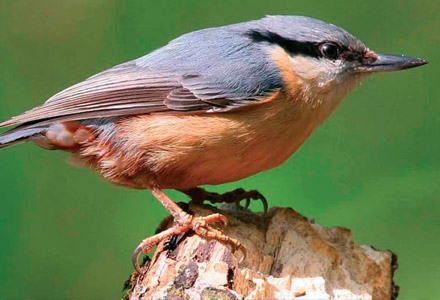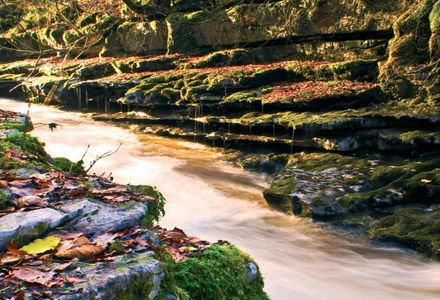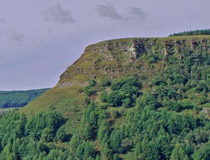| |

Marsh Fritillary Butterfly Primarily a wetland species as its name suggests, these beautiful butterflies have been declining in numbers in recent years as their natural habitats have become increasingly scarce. However, in areas of the valleys, they are more than holding their own. Adults emerge in the middle of May, reaching a peak in early June. Image courtesy of © Cumbria Butterfly Conservation
|
|
To those unfamiliar with the Valleys, they can still evoke images of scarred hillsides dominated by spoil heaps and waste tips. Nowadays, as residents know, the hills are largely green again, rivers full of fish run clean, such that visitors are often taken aback by the beautiful countryside that envelopes the towns and villages of The Valleys. And places to see and explore nature are close at hand.
TAKE A WALK ON THE WILD SIDE
The Valleys will have a new National Nature Reserve this summer. Aberbargoed Grasslands in the Rhymney Valley is already designated as a Special Area of Conservation (SAC) and a Site of Special Scientific Interest (SSSI) of national and European importance. Its Purple Moor grass and rush pasture habitat is increasingly rare with more than 90% of it lost across Britain over the last 100 years. It supports a huge variety of wildlife including a colony of rare Marsh Fritillary butterflies.
Subject to the approval of the Countryside Council for Wales (CCW), the reserve is likely to be launched during Wales Biodiversity Week, commencing on June 11, with a series of community events, including a butterfly parade involving local schools. A new education centre is being created at the site and specially developed apps for iPhones and Android phones will help visitors understand and enjoy the reserve and the wildlife.
Before the official launch, Caerphilly CBC countryside rangers are hosting a party of nearly 50 'Ecogardes' from northern France and volunteer rangers from Belgium at the grasslands to undertake activities as part of the trans-European WECAN project in which the Valleys Regional Park initiative is a partner.
Just a few miles to the north of the grasslands and the town of Bargoed, Parc Cwm Darran, one of the Valleys' wonderful Country Parks, is a great example of how former industrial sites have been reclaimed for nature and recreational purposes.
The location of the former Ogilvie Colliery is now a tranquil haven where two lakes have been created, surrounded by thousands of trees. The park's wonderful walking and cycling trails allow visitors to reconnect with nature and wildlife, especially at Cwmllywdrew Meadows, a Local Nature Reserve within the park, where Barn Owls hunt and Pied Flycatchers nest.

A nuthatch at Silent Valley Nature Reserve
Image courtesy of © Lee Parsons
Just off the Ebbw Fawr valley is Cwm Merddog, home to the Silent Valley reserve. Within the woodlands at Silent Valley, the remnants of the old dramline that transported coal from the drift mines on the hillsides can still be seen.
Gwent Wildlife Trust and its partners have done a sterling job in managing the reserve for both conservation purposes and the enjoyment of visitors. The Trust runs the newly-built Environment Resource Centre nearby on the site of the former steel works at Ebbw Vale and is certainly well worth a visit as well.
In addition to its magnificent variety of ferns, wild orchids and helleborines, Silent Valley claims the highest-altitude beech woodlands in mainland Britain. The adventurous may wish to check if they are higher than those perched on the punchbowl above Cwm Tyleri, just north of the local nature reserve at Cwmtillery Lakes, one of three such reserves along with Beaufort Woodlands and Parc Nant-y-Waun on the new Ebbw Fach Trail, a 16 km trail that links fourteen community-run greenspaces.
The endlessly-fascinating contrast and relationship between man's activities and nature often enhances the appeal of The Valleys' wildlife sites. One of the many regeneration projects and initiatives that are helping to transform the valleys is that at Cyfarthfa Park and Castle restoring the old Tramway and the historic Leat, which supplied water to the famous Cyfarthfa ironworks.
Here a new walkway will form part of a heritage trail between Cyfarthfa and the Taf Fechan Nature Reserve. The reserve is part of the Cwm Taf Fechan Woodland SSSI where the fast-flowing Taf Fechan river cuts through close to limestone cliffs. The Wildlife Trust of South and West Wales has leased the site since 1975 from Merthyr Tydfil County Borough Council, with whom they jointly run and manage it, and recently they have appointed its first ever full-time warden to look after it.
 The Taf Fechan
The Taf Fechan
Image: © Peter M Jeffs
PMJay@pmjay.com
Just north of Swansea, close to the village of Craig Cefn Parc, the RSPB runs a nature reserve, also named Cwm Clydach. This has two special nature trails: a short one, which is suitable for pushchairs, and a longer one with steep, rocky sections. You might see spotted flycatchers and redstarts. Dippers and Grey Wagtails frequent the waters of the Clydach River whilst majestic Red Kites, with their iconic forked tails, can often be seen gliding overhead in their distinctive graceful fashion.
If you fancy a walk on the wild side near you this summer, you know where to go.
Essential Nature

Tucked out of sight just off the 'Heads of the Valleys' Road to the east of Brynmawr is the Cwm Clydach National Nature Reserve, which recently featured as one of the 'Top 50 Valleys Essentials' by 'Rough Guide to Wales' author Mike Parker.
The reserve is managed by CCW as part of the wider Cwm Clydach Woodlands SAC. Beech trees cling to the side of the deep limestone gorge cut by the Afon Clydach, which resonates in the summer to a symphony of songs from birds including the Nuthatch, Green and Lesser Spotted Woodpeckers.
A new cycleway, which links to the Sustrans' Valleys Cycle Network, passes through the reserve along the route of the old railway line.
To discover more about nature
reserves, and other wild places and
attractions in The Valleys, visit:
www.thevalleys.co.uk

The magnificent crags of Pen Pych at
the top of the Rhondda Fawr, one of
only a few flat-topped spur mountains
in Europe, where buzzards and
peregrines often soar on the thermals.
Just to the south of Pen Pych is the
fantastic SSSI woodland at Cwm
Saerbren.
Notable for its wonderful geological
features, the site is accessible from
Treherbert railway station.
The WECAN project is a European Interreg IVB Project with partners from Valleys Regional Park, Regionaal Landschap Kempen en Maasland in Belgium, Parcs Naturels Regionaux Scarpe Escaut and L'Avesnois in France. More details at: www.thevalleys.org.uk |
|
|
SISTER MAGAZINES
 
|
|





 The Taf Fechan
The Taf Fechan


